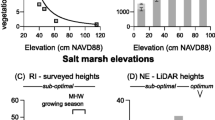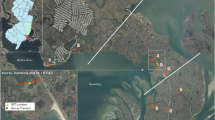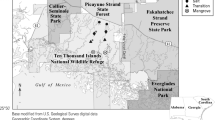Abstract
This study investigated how changes in salt marsh soil properties and topography on sediment fans related to shifts in salt marsh plant community composition in the Elkhorn Slough Watershed, California, USA. Several sediment fans have formed in this watershed as soil eroding from farms moved downslope, filling marshes, mudflats, and channels. Sandy sediment deposition increased marsh plain elevation and altered edaphic properties by increasing bulk density and decreasing soil moisture, salinity, and soil nitrogen compared to reference sites. These changes created a strong wetlandupland gradient and influenced the development of well-defined vegetation zones from wetland to upland: pickleweed (Salicornia virginica), cattail (Typha spp.) and bulrush (Scirpus spp.), and arroyo willow (Salix lasiolepis). Based on statistical analysis, arroyo willow grew in a distinct edaphic environment, and its expansion into the salt marsh was restricted by elevation in tidal areas greater than 1.80 m NAVD 88, spring soil moisture levels lower than 20%, and year-round salinity levels lower than 2.67 dS/m. Cattail and bulrush were present in transitional environmental conditions with fluctuating salinity and at an elevation similar to that of the pickleweed community. The hydrogeologic setting played a part in this change, as the contribution of upland sandy soils likely facilitated the emergence of new edaphic properties including lower salinity, lower soil moisture, and reduced soil nutrients. The findings in this study underline the importance of on-going erosion-control efforts to estuarine conservation in Central California.
Similar content being viewed by others
Literature Cited
Allison, S. K. 1995. Recovery from small-scale anthropogenic disturbances by Northern California salt marsh plant assemblages. Ecological Applications 5: 693–702.
Allison, S. K. 1996. Recruitment and establishment of salt marsh plants following disturbance by flooding. American Midland Naturalist 136: 232–247.
Austin, M. P. and T. M. Smith. 1989. A new model for the continuum concept. Vegetatio 83: 35–47.
Barbour, M. G., J. H. Burk, W. D. Pitts, F. S. Gilliam, and M. W. Schwartz. 1999. Terrestrial Plant Ecology, third edition. Benjamin/Cummings, Menlo Park, CA, USA.
Barbour, M. G. and C. B. Davis. 1970. Salt tolerance of five California salt marsh plants. American Midland Naturalist 84: 262–265.
Beare, P. A. and J. B. Zedler. 1987. Cattail invasion and persistence in a coastal salt marsh: The role of salinity reduction. Estuaries 10: 165–170.
Bedford, B. 1999. Cumulative effects on wetland landscapes: links to wetland restoration in the United States and Southern Canada. Wetlands 19: 775–788.
Bertness, M. D. 1991a. Interspecific interactions among high marsh perennials in a New England salt marsh. Ecology 72: 125–137.
Bertness, M. D. 1991b. Zonation of Spartina patens and Spartina alterniflora in a New England salt marsh. Ecology, 138–148.
Blake, G. R. and K. H. Hartge. 1986. Bulk Density. p. 363–375, In A. Klute (ed.) Methods of Soil Analysis: Part 1: Physical and Mineralogical Methods. Monograph Number 9 (second edition). American Society of Agronomy — Soil Science Society of America, Madison, WI, USA.
Boggs, S. 1987. Principles of Sedimentology and Stratigraphy. Merrill Publishing Company, Columbus, OH, USA.
Boyer, K. E., P. Fong, R. R. Vance, and R. F. Ambrose. 2001. Salicornia virginica in a southern California salt marsh: seasonal patterns and a nutrient-enrichment experiment. Wetlands 21: 315–326.
Boyer, K. E. and J. B. Zedler. 1998. Effects of nitrogen additions on the vertical structure of a constructed cordgrass marsh. Ecological Applications 8: 692–705.
Brady, N. C. and R. R. Weil. 1999. The Nature and Properties of Soils, 12th edition. Prentice-Hall, Inc., Upper Saddle River, NJ, USA.
Breiman, L., J. H. Friedman, R. A. Olshen, and C. J. Stone. 1984. Classification and Regression Trees. Chapman and Hall, New York, NY, USA.
Byrd, K. B., N. M. Kelly, and E. van Dyke. 2004. Decadal changes in a Pacific estuary: A multi-source remote sensing approach for historical ecology. GIScience and Remote Sensing 41: 285–308.
Caffrey, J., M. Brown, W. B. Tyler, and M. Silberstein. (eds.). 2002. Changes in a California Estuary: a Profile of Elkhorn Slough. Elkhorn Slough Foundation, Moss Landing, CA, USA.
Caffrey, J., S. Shaw, M. Silberstein, A. de Vogelaere, and M. White. 1997. Water Quality Monitoring in Elkhorn Slough: a summary of results 1988–1996. Elkhorn Slough Foundation and Elkhorn Slough National Estuarine Research Reserve, Watsonville, California, USA.
Callaway, J. C., R. D. DeLaune, and W. H. Patrick. 1997. Sediment accretion rates from four coastal wetlands along the Gulf of Mexico. Journal of Coastal Research 13: 181–191.
Chmura, G. L., R. Costanza, and E. C. Kosters. 1992. Modelling coastal marsh stability in response to sea level rise: a case study in coastal Louisiana, USA. Ecological Modelling 64: 47–64.
Connell, J. and R. Slatyer. 1977. Mechanisms of succession in natural communities and their role in community stability and organization. American Naturalist 111: 1119–1144.
De’ath, G. and K. E. Fabricus. 2000. Classification and regression trees: a powerful yet simple technique for ecological data analysis. Ecology 81: 3178–3192.
Dickert, T. G. and A. E. Turtle. 1980. Elkhorn Slough Watershed: Linking the cumulative impacts of watershed development to coastal wetlands. Institute of Urban and Regional Development, University of California, Berkeley, CA, USA.
Dickert, T. G. and A. E. Turtle. 1985. Cumulative impact assessment in environmental planning: A coastal wetland watershed example. Environmental Impact Assessment Review 5: 37–64.
Drury, W. and I. Nisbet. 1973. Succession. Journal of the Arnold Arboretum 54: 331–368.
Ewing, K. 1996. Tolerance of four wetland plant species to flooding and sediment deposition. Environmental and Experimental Botany 36: 131–146.
Feldesman, M. R. 2002. Classification trees as an alternative to linear discriminant analysis. American Journal of Physical Anthropology 119: 257–275.
Gardner, W. H. 1986. Water Content. p. 493–544, In A. Klute (ed.) Methods of Soil Analysis: Part 1: Physical and Mineralogical Methods. Monograph Number 9 (second edition). American Society of Agronomy — Soil Science Society of America, Madison, WI, USA.
Gleason, R. A., J. N. H. Euliss, D. E. Hubbard, and W. G. Duffy. 2003. Effects of sediment load on emergence of aquatic invertebrates and plants from wetland soil egg and seed banks. Wetlands 23: 26–34.
Godwin, K. S., J. P. Shallenberger, D. J. Leopold, and B. L. Bedford. 2002. Linking landscape properties to local hydrogeologic gradients and plant species occurrence in minerotrophic fens of New York State, USA: A hydrogeologic setting (HGS) framework. Wetlands 22: 722–737.
Greer, K. and D. Stow. 2003. Vegetation type conversion in Los Penasquitos Lagoon, California: An examination of the role of watershed urbanization. Environmental Management 31: 489–503.
Gustafson, S. and D. Wang. 2002. Effects of agricultural runoff on vegetation composition of a priority conservation wetland, Vermont, USA. Journal of Environmental Quality 31: 350–357.
Hart, S. C., J. M. Stark, E. A. Davidson, and M. K. Firestone. 1994. Nitrogen mineralization, immobilization, and nitrification. p. 985–1018, In R. W. Weaver, S. Angle, P. Bottomley, D. Bezdicek, S. Smith, A. Tabatabai, and A. Wollum (eds.) Methods of Soil Analysis: Part 2: Microbiological and Biochemical Properties. American Society of Agronomy — Soil Science Society of America, Madison, WI, USA.
Hopkinson, C. S. and J. J. Vallino. 1995. The relationship among man’s activities in watersheds and estuaries: a model of runoff effects on patterns of estuarine community metabolism. Estuaries 18: 598–621.
Howarth, R. W., J. R. Fruci, and D. Sherman. 1991. Inputs of sediment and carbon to an estuarine ecosystem: Influence of land use. Ecological Applications 1: 27–39.
Johnston, C. A. 2003. Shrub species as indicators of wetland sedimentation. Wetlands 23: 911–920.
Jurik, T. W., S. C. Wang, and A. G. van der Valk. 1994. Effects of sediment load on seedling emergence from wetland seed banks. Wetlands 14: 159–165.
Karrenberg, S., P. J. Edwards, and J. Kollmann. 2002. The life history of Salicaceae living in the active zone of floodplains. Freshwater Biology 47: 733–748.
Koning, C. O. 2004. Impacts of small amounts of sandy sediment on wetland soils and vegetation: results from field and greenhouse studies. Wetlands 24: 295–308.
Kuhn, N. L. and J. B. Zedler. 1997. Differential effects of salinity and soil saturation on native and exotic plants of a coastal salt marsh. Estuaries 20: 391–403.
McBride, J. and J. Strahan. 1984. Establishment and survival of woody riparian species on gravel bars of an intermittent stream. American Midland Naturalist 112: 235–245.
Mueller-Dombois, D. and H. Ellenberg. 1974. Aims and Methods of Vegetation Ecology. John Wiley & Sons, Inc., New York, NY, USA.
Nakamura, F., S. Kameyama, and S. Mizugaki. 2004. Rapid shrinkage of Kushiro Mire, the largest mire in Japan, due to increased sedimentation associated with land-use development in the catchment. Catena 55: 213–229.
NOAA-NGS. 2005. Center for Operational and Oceanographic Products and Services/National Geodetic Survey (CO-OPS/NGS) Elevation Data. http://www.ngs.noaa.gov/cgi-bin/ngs_opsd.prl.
Noe, G. B. and J. B. Zedler. 2001. Spatio-temporal variation of salt marsh seedling establishment in relation to the abiotic and biotic environment. Journal of Vegetation Science 12: 61–74.
Orians, C. M., D. I. Bolnick, B. M. Roche, R. S. Fritz, and T. Floyd. 1999. Water availability alters the relative performance of Salix sericea, Salix eriocephala, and their F1 hybrids. Canadian Journal of Botany 77: 514–522.
Owen, C. R. 1999. Hydrology and history: land use changes and ecological responses in an urban wetland. Wetland Ecology and Management 6: 209–219.
Pennings, S. and R. Callaway. 1992. Salt marsh plant zonation: the relative importance of competition and physical factors. Ecology 73: 681–690.
Rhoades, J. D. 1982. Soluble salts. p. 167–179, In A. L. Page (ed.) Methods of Soil Analysis: Part 2: Chemical and microbiological properties. Monograph Number 9, second edition. American Society of Agronomy — Soil Science Society of America, Madison, WI, USA.
Richards, L. A. (ed.). 1954. Diagnosis and Improvement of Saline and Alkali Soils, Agricultural Handbook No. 60. USDA, Agricultural Research Service, Soil and Water Conservation Research Branch, Washington, DC, USA.
Sacchi, C. and P. Price. 1992. The relative roles of abiotic and biotic factors in seedling demography of arroyo willow (Salix lasiolepis: Salicaceae). American Journal of Botany 79: 395–405.
Sheldrick, B. H. and C. Wang. 1993. Particle-size distribution. p. 488–511, In M. R. Carter (ed.) Soil Sampling and Methods of Analysis. Canadian Society of Soil Science, Lewis Publishers, Ann Arbor, MI, USA.
Snow, A. A. and S. W. Vince. 1984. Plant zonation in an Alaskan salt marsh. II. An experimental study of the role of edaphic conditions. Journal of Ecology 72: 699–684.
StatacorpLP. 1985–2004. Intercooled Stata 8.2 for Windows. College Station, TX, USA.
Switala, K. 1999. Determination of Ammonia by Flow Injection analysis. QuikChem Method 10-107-06-1-A. Lachat Instruments, Milwaukee, WI, USA.
Tabachnick, B. G. and L. S. Fidell. 1996. Using Multivariate Statistics, third edition. Harper Collins, New York, NY, USA.
The R Foundation for Statistical Computing. 2004. R 1.9.1. www.r-project.org.
USDA-NRCS. 2002. The Elkhorn Slough Watershed Project 2000–2001 Report. Natural Resources Conservation Service, Salinas, CA, USA.
USDA-NRCS. 2004. Soil Survey Geographic (SSURGO) Database for Monterey County, California. USDA Natural Resources Conservation Service, Fort Worth, TX, USA.
USDA-NRCS and RCDMC (Resource Conservation District of Monterey County). 2004. Elkhorn Slough Watershed Permit Coordination Program 2003 Implementation Report. USDA Natural Resources Conservation Service and Resource Conservation District of Monterey County, Salinas, CA, USA.
USDA-SCS. 1984. Strawberry hills target area. Watershed area study report. Soil Conservation Service, Monterey County, CA, USA.
van Dyke, E. and K. Wasson. 2005. Historical ecology of a central California estuary: 150 years of habitat change. Estuaries 28: 173–189.
Vayssieres, M. P., R. E. Plant, and B. H. Allen-Diaz. 2000. Classification trees: an alternative non-parametric approach for predicting species distributions. Journal of Vegetation Science 11: 679–694.
Vivian-Smith, G. 1997. Microtopographic heterogeneity and floristic diversity in experimental wetland communities. Journal of Ecology 85: 71–82.
Wang, S. C., T. W. Jurik, and A. G. van der Valk. 1994. Effects of sediment load on various stages in the life and death of cattail (Typha × glauca). Wetlands 14: 166–173.
Ward, K. M., J. C. Callaway, and J. B. Zedler. 2003. Episodic colonization of an intertidal mudflat by native cordgrass (Spartina foliosa) at Tijuana Estuary. Estuaries 26: 116–130.
Wardrop, D. and R. Brooks. 1998. The occurrence and impact of sedimentation in central Pennsylvania wetlands. Environmental Monitoring and Assessment 51: 119–130.
Waters, I. and J. M. Shay. 1992. Effect of water depth on population parameters of a Typha × glauca stand. Canadian Journal of Botany 70: 349–351.
Watson, E. B. 2004. Changing elevation, accretion, and tidal marsh plant assemblages in a South San Francisco Bay tidal marsh. Estuaries 27: 684–698.
Weis, D. A., J. C. Callaway, and R. M. Gersberg. 2001. Vertical accretion rates and heavy metal chronologies in wetland sediments of the Tijuana Estuary. Estuaries 24: 840–850.
Wendt, K. 1999. Determination of Nitrate/Nitrite by Flow Injection Analysis (Low Flow Method). QuikChem Method 10-107-04-1-A. Lachat Instruments, Milwaukee, WI, USA.
Werner, K. J. and J. B. Zedler. 2002. How sedge meadow soils, microtopography, and vegetation respond to sedimentation. Wetlands 22: 451–466.
Wetzel, P. R. and A. G. van der Valk. 1998. Effects of nutrient and soil moisture on competition between Carex stricta, Phalaris arundinacea, and Typha latifolia. Plant Ecology 138: 179–190.
Wilcox, D. A. 1986. The effects of deicing salts on vegetation in Pinhook Bog, Indiana. Canadian Journal of Botany 64: 865–874.
Winter, T. C. 1988. A conceptual framework for assessing cumulative impacts on the hydrology of nontidal wetlands. Environmental Management 12: 605–620.
Winter, T. C. 1992. A physiographic and climatic framework for hydrologic studies of wetlands. p. 127–148, In R. D. Robarts and M. L. Bothwell (eds.) Aquatic Ecosystems in Semi-arid Regions: Implications for Resource Management N.H.R.I. Symposium Series 7. Environment Canada, Saskatoon, SK, Canada.
Woo, I. and J. B. Zedler. 2002. Can nutrients alone shift a sedge meadow towards dominance by the invasive Typha × glauca?. Wetlands 22: 509–521.
WRCC (Western Regional Climate Center). 2005. Annual Rainfall Data, Watsonville Waterworks Station 049473. http://www.wrcc.dri.edu/cgi-bin/cliMAIN.pl?cawats+nca.
Zedler, J. B., J. C. Callaway, J. S. Desmond, G. Vivian-Smith, G. D. Williams, G. Sullivan, A. E. Brewster, and B. K. Bradshaw. 1999. California salt marsh vegetation: an improved model of spatial pattern. Ecosystems 2: 19–35.
Author information
Authors and Affiliations
Corresponding author
Rights and permissions
About this article
Cite this article
Byrd, K.B., Kelly, M. Salt marsh vegetation response to edaphic and topographic changes from upland sedimentation in a Pacific estuary. Wetlands 26, 813–829 (2006). https://doi.org/10.1672/0277-5212(2006)26[813:SMVRTE]2.0.CO;2
Received:
Revised:
Accepted:
Issue Date:
DOI: https://doi.org/10.1672/0277-5212(2006)26[813:SMVRTE]2.0.CO;2




